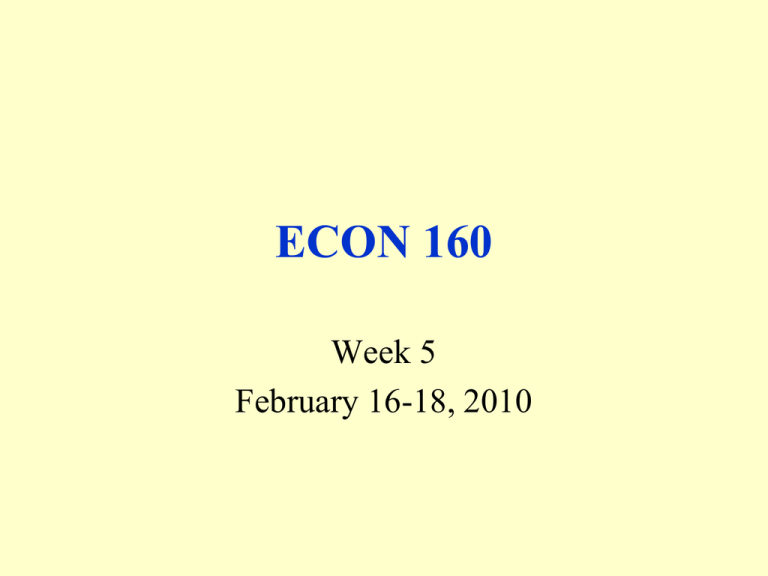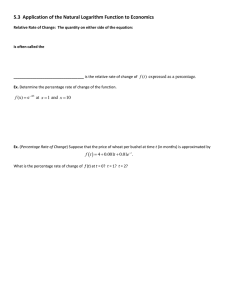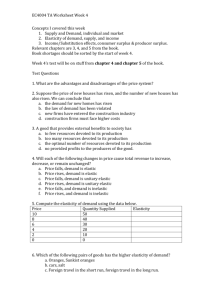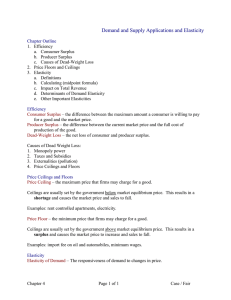E160.S10.W05.Dynamics.TCost.Elasticity_000
advertisement

ECON 160 Week 5 February 16-18, 2010 Review • Markets are the interaction of buyers and sellers. • Focus on buyers and sellers separately. • Ceteris paribus: look at one thing at a time; All other things held equal. Demand for X $Px $ 10 $ 9 $ 8 $ 7 $ 6 $ 5 $ 4 $ 3 $ 2 $ 1 Dx Demand shows the amounts purchased at alternative prices (horizontal distances at each price) Demand x Dx 1 2 3 4 5 6 7 8 9 10 Qtyx /T Supply Curve $Price $10 8 6 4 2 2 T 4 6 8 10 12 14 16 Qty x/ $Price $4 3 Demand Surplus at this $ Price 2.50 Supply 2.00 1.50 1.00 .50 .25 100 200 300 400 500 600 700 800 900 1000 1100 Q x/ T $Price $4 Demand 3 2.50 Supply 2.00 1.50 1.00 .50 .25 Shortage at this $ Price 100 200 300 400 500 600 700 800 900 1000 1100 Q x/ T Market Equilibrium $Price 4 3 2.50 2.00 Demand Supply Qty D = Qty S 1.50 Pe 1.00 .50 .25 100 200 300 400 500 600 700 800 900 1000 1100 Q x/ T Qe $Px $ 10 $ 9 $ 8 $ 7 Pe $ 6 $ 5 $ 4 $ 3 $ 2 $ 1 Total Revenue = P X Q Demand $6x5 = $30 Supply Dx 1 2 3 4 5 6 7 8 9 10 11 12 Qe Qtyx /T $Px $ 10 $ 9 $ 8 $ 7 Pe $ 6 $ 5 $ 4 $ 3 $ 2 $ 1 Effects of Increase in Demand on Price and Quantity Do D1 Supply Increases Price and Quantity Sx D1 Do 1 2 3 4 5 6 7 8 9 10 11 12 Qe Qtyx /T $Px $ 10 $ 9 $ 8 $ 7 $ 6 $ 5 $ 4 $ 3 $ 2 $ 1 Demand Determines Price D3 Supply: Response D2 Demand pulls forth output D1 D3 Sx D2 D1 1 2 3 4 5 6 7 8 9 10 11 12 Qtyx /T $Px $ 10 $ 9 $ 8 $ 7 Pe $ 6 $ 5 $ 4 $ 3 $ 2 $ 1 Effects of an Increase in Supply on Price and Quantity S0 Demand S1 Price decreases and Quantity increases S0 Dx S1 1 2 3 4 5 6 7 8 9 10 11 12 Qe Qtyx /T Transaction Costs of Exchange • Information Costs – – • • Search Costs Quality Identification Cost Negotiating Costs: Cost of agreeing on what and how much will be exchanged Transportation Costs: Cost of moving goods between parties 12 Slope Shows Responsiveness of Quantity to a Change in Price B A Px Px P0 P0 P1 P1 Dx Dx Q0Q1 Qx/T Q0 Q1 Qx/T Slope of Supply Shows responsiveness of quantity to a change in Price A B Px Px P1 P1 P0 P0 Q0 Q1 Qx/T Q0 Q1 Qx/T Elasticity: a Measure of responsiveness of Quantity to a Change in Price • Ed = % Δ Qd/ % Δ price • Es = % Qs / % price Measures of Elasticity • Demand is Elastic : %Δ Qd > %Δ P; ie |Ed| >1. A decrease in Price an increase in Total Revenue. • Demand is Unitary Elastic: %ΔQd = %ΔP; ie |Ed| = 1. A Change in price no change in Total Revenue. • Demand is Inelastic: %ΔQd < %ΔP; i.e. |Ed| < 1. An increase in Price an increase in Total Revenue. Elasticity, Price Change & Total Revenue $Px Elastic $Px Inelastic P1 P0 P0 P1 Q0 Q1 Q1 Q0 Qty/T $Px Increased Demand with elastic Supply $ 10 $ 9 $ 8 Pe`$ 7 Pe $ 6 $ 5 $ 4 $ 3 $ 2 $ 1 Dx Sx Sx Dx` Dx 1 2 3 4 5 6 Qe 7 8 9 Qe` 10 11 12 Qtyx /T Increased Demand , Inelastic Supply $Px $ 10 $ 9 $ 8 Pe’$ 7 $ 6 Pe $ 5 $ 4 $ 3 $ 2 $ 1 Sx Dx Dx’ Sx Dx 1 2 3 4 5 6 7 8 9 10 11 12 Qe Qe’ Qtyx /T $Px $ 10 $ 9 $ 8 Pe`$ 7 Pe $ 6 $ 5 $ 4 $ 3 $ 2 $ 1 Decrease in Supply, Elastic Demand Dx Sx’ Sx Dx 1 2 3 4 5 6 7 8 9 10 11 12 Qe` Qe Qtyx /T $Px $ 10 $ 9 $ 8 Pe’$ 7 $ 6 Pe $ 5 $ 4 $ 3 $ 2 $ 1 Decrease in Supply, Inelastic Demand Dx Sx’ Sx Dx 1 2 3 4 5 6 7 8 9 10 11 12 Qe’ Qe Qtyx /T Determinants of Price Elasticity of Demand • Number & Closeness of Substitutes. • Information about price change and availability of substitutes. • Percentage of Income Spent on good. • Period of time: Second Law of Demand: Demand is more elastic over a longer period of time. Other Elasticity's A Measure of responsiveness of Quantity to a Change in some other factor Income Elasticity: Measure of responsiveness of Quantity to a Change in Income • EdI = % Δ Qd/ % Δ income • EdI = 100 * ΔQ/Q = I * ΔQ 100 * ΔI/I Q * ΔI • Normal Goods: Positive • Clothing: .95: 10% income → 9.5% • Stereo: 27.2: 10% income → 27.2% • Increase may be Quantity or Quality • Inferior Goods: Negative Cross Price Elasticity: Measure of responsiveness of Quantity to a Change Price of other good • Exy = % Δ Qx/ % Δ Py • EdI = 100 * ΔQx/Qx = Py * ΔQx 100 * ΔPy/Py Qx * ΔPy • Substitutes: Positive • Complements: Negative Uses of Cross Price Elasticity • Magnitude of cross price elasticity reflects closeness of substitutes or complements • Able to identify your closest competitors • Courts use cross-price to measure monopoly power Transaction Costs of Exchange • Information Costs – – • • Search Costs Quality Identification Cost Negotiating Costs: Cost of agreeing on what and how much will be exchanged Transportation Costs: Cost of moving goods between parties 27








